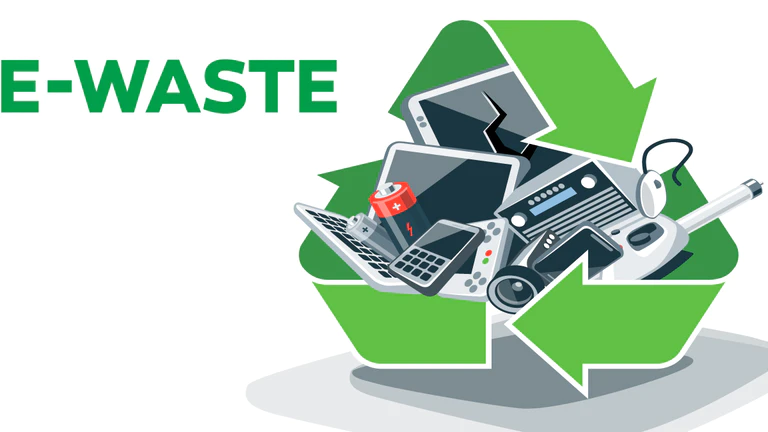From Individuals to Businesses- How To Make A Difference
The term “e-waste” is an abbreviation of “electronic and electrical waste”; waste as in no longer useful, garbage. Devices that become e-waste include:
- Cameras
- CD players
- Cell phones
- Computer monitors
- Computers
- Drones
- DVDs
- Electric scooters
- Fax machines
- GPS devices
- Landline telephones
- Laptop computers
- Modems and routers
- MP3 players (such as old iPods)
- Pagers
- PDAs
- Photocopiers
- Portable speakers
- Printers
- Projectors
- Radios
- Roombas
- Scanners
- Security cameras
- Smart bathroom scales
- Smartphones
- Stereos
- Tablets
- Televisions (tube, plasma, and LCD, LED)
- VCRs
- Video game consoles
- Virtual assistants (Amazon Echo, Google Home, etc.)
- Virtual reality (VR) gear
Why A Problem?
It seems accurate to assume that many people would never think of their electronic device or equipment to be hazardous- how can this sleek looking little machine cause any harm? It’s the ingredients that make up these devices in where the harm lies. Ingredients such as:
- Arsenic -can cause cancer & skin lesions
- Beryllium -a metal that can damage lungs when breathed in
- Brominated flame retardants -can affect the endocrine, immune, reproductive, and nervous systems
- Cadmium –can cause kidney disease and weak bones
- Lead -can cause anemia and brain damage
- Mercury -its vapour can produce harmful effects on the nervous, digestive and immune systems, lungs and kidneys, and may be fatal
As you can see, all of these elements can cause severe illness. People most at risk include workers that directly handle e-waste, communities around landfills where e-waste is decomposing, and communities where excess e-waste has been shipped.
Atmosphere Impact
When burning e-waste (sometimes done to extract the copper), the toxic components inside are released into the air causing massive harmful pollution and negatively affecting air quality.
Water Impact
Some of the metals in electronic devices can leak into the soil and reach the groundwater supply. This groundwater moves into streams, ponds, lakes, and rivers, ultimately making the water tables toxic and unusable for communities, animals, and plants.
Soil Impact
As e-waste impacts water, so it impacts soil. Contaminated water tables find their way into food producing crop land, and render it unviable for clean food production.
Fastest Growing Waste Issues
The Global E-waste Monitor 2017 shows that e-waste has grown to 44.7 million metric tons annually.
- Only 20% of the e-waste generated is documented to be collected and recycled.
- 34.1 million metric tons is dumped, traded or recycled under inferior conditions.
- E-waste is growing exponentially as global demand continues to increase.
- Shorter replacement cycles are contributing to the growth of e-waste.
E-waste Management Organizations
In the U.S., there’s the National Center for Electronics Recycling (NCER). The organization was founded to assist with the implementation of electronics recycling programs across the country. Success has been robust thus far, diverting thousands of pounds of electronics from local landfills, boosted the recycling industry, and increased awareness.
What Can You Do?
As consumers, there are plenty of ways we can reduce e-waste. For example:
- If you don’t need it, don’t buy it (like that fancy new iPhone).
- Extend the life of your devices with cases and screen protectors; keep your device clean, and avoid overcharging the battery.
- Buy products with the Energy Star Label, or certified by the Electronic Product Environmental Assessment Tool (EPEAT), and other markings that indicate sustainability.
- Dispose responsibly, by selling, donating, or finding out where it can be recycled.
- Donate used electronics to social programs, many help victims of domestic violence, children safety initiatives, environmental causes, and more.
- Upgrade instead or purchase new- additional memory, hard drives, or software upgrades can make old electronics feel newer and work more efficiently. This will lower the rate of e-waste.
Trade-In To Upgrade
Taking advantage of trade-in programs when upgrading is especially important in large companies where electronics are provided for every staff member, sometimes multiple devices as well as work-from-home duplicates now as well. Many manufacturers offer e-waste recycling programs. For example, Best Buy’s “buy-back-program” will purchase old electronics for a reward or discount. As of 2019, Best Buy has collected an impressive 2 billion pounds of e-waste and counting. A reminder that trading in your gadgets helps save raw materials, makes the process of building electronics cheaper, and is more energy-efficient.
Donate to Nonprofits
This was mentioned above but worth repeating: give used devices a second life at local public schools, non-profits, or community groups in underserved populations. As of 2004, Dell and Goodwill have partnered together to collect more than 96 million pounds of electronics and have recently expanded the program to over 1,900 Goodwill locations.
Local Recycling
As of 2020, 25 states have a statewide electronic waste program. California was the first state to present the Electronic Waste Recycling Act of 2003, establishing a system for collecting and recycling certain types of electronic waste. Many other states plus popular retail stores will collect unwanted electronic devices, including TV’s, computers, batteries, and more. If you are interested, you can find an electronic recycling center near you by following this link.
Summary
Technology is doing nothing but gaining momentum. That translates to shorter lifespans for electronics and greater electronic waste. Every individual and every company has the responsibility to make e-waste reduction and recycling a priority. By doing so, natural resources are protected, our air, water and soil remain safer from pollution, carbon footprints are reduced, and landfills are not needlessly overfilled with toxic materials around the world.
#ewaste #recycling #escrap #electronicwaste #ewasterecycling #recycle #industrialwaste #itrecycling #metalscrap #officebin #sustainability #reuse #rorobin #environment #waste #wastemanagement #circulareconomy #computerrecycling #electronics #zerowaste #reduce #laptoprecycling #scrap #datadestruction #gpurecycling #psurecycling #pcrecycling #harddiskrecycling #lcdrecycling #serverrecycling #halfcutlaptop #electronicrecycling #ramrecycling #sampahelektronik #electricalwaste #upcycle #computer #halfcutpc #halfcutprinter #sampah #gogreen #itad #wasteelectronic #wasteelectrical #electronicsrecycling #awareness #elektronik #ecofriendly #technology #reducewaste

